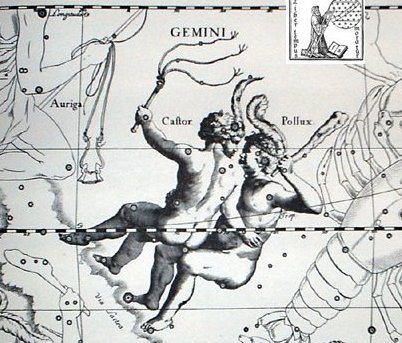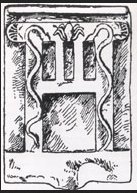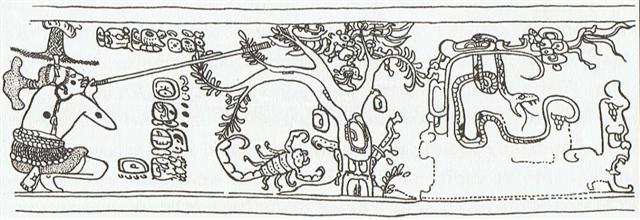|
6. The Hevelius view is different. We have to adjust to a mirror order for the right ascension (but not for the declination, the top does not change to the bottom and vice versa when looking into a mirror):  Castor has a whip in his left hand and also Pollux is using his the left hand. But in a mirror right becomes left. The ground map of the Great Pyramids of Gizah has not been drawn as in a mirror, instead - we have seen, cfr at The Armpit, - the normal view is rotated 180º around. Looking up from the Nile delta towards the south the pyramid of Menkaure will be at right on the ground (precisely as when looking up in the night at Mintaka in the sky which rises earlier than the other 2 stars in the belt of Orion) and the pair of even greater pyramids will be to the left (precisely as when we can see Alnilam and Alnitak to the left of Mintaka). The G text has right ascension increasing to the right, which seems right. Also the view of Hevelius is natural for us who read from left to right, it is a representation of what we can see from the outside of the celestial sphere. The immortal Pollux is rising later than the mortal Castor. In the view from the inside of the celestial sphere Pollux will be to the left of Castor. Left will turn into right when we move from the inside to the outside and look back. The key is whether we look back or not. There is no string instrument between the twins of Hevelius and instead strings are drawn outside, in the whip. The other part of the instrument is probably drawn at the end of the reins of Auriga, hanging down like the lifeless bit of a no longer visible horse. Hevelius has drawn the frame of the bit lyre as an elongated upside down Ω with its 'eyes' in reins and with added 'legs' in chains. The idea evidently is to show how the extra bottom part has been 'entangled', not in strings but in chains. That seems to be the method for making Moon stand still - cfr how Andromeda was chained to the rock at the margin of the sea. If we then go back to the dokana relief on the Lakonian grave we can perceive a similar construction, with one part above and another below:
The serpents are like undulating locks of hair hanging down. The great opening at bottom is like a mouth. Above are a pair of empty eye sockets with a central (more narrow) opening where the nose once was. The pattern is basically vertical but the horizontal beam above means this 'death skull' is below the surface of the earth - it is a grave. Castor (the mortal one) has strings whereas Pollux carries a 'great stick'. The logic of contrasts says strings should be down in the 'water' - which of course is useful for catching fish - whereas trees cannot grow without the rays and sweet water from Sun, without being above ground. Trees must be on the outside of the globe of earth. But at the bottom of the World Tree (the origin of 'sticks') there is a 'great mouth', because there must be nourishing roots below ground. This is evidently also the Mayan view (cfr at King Cepheus):
At the top of the Tree rules the opposite of the great mouth at bottom, viz. the god of life:
|


